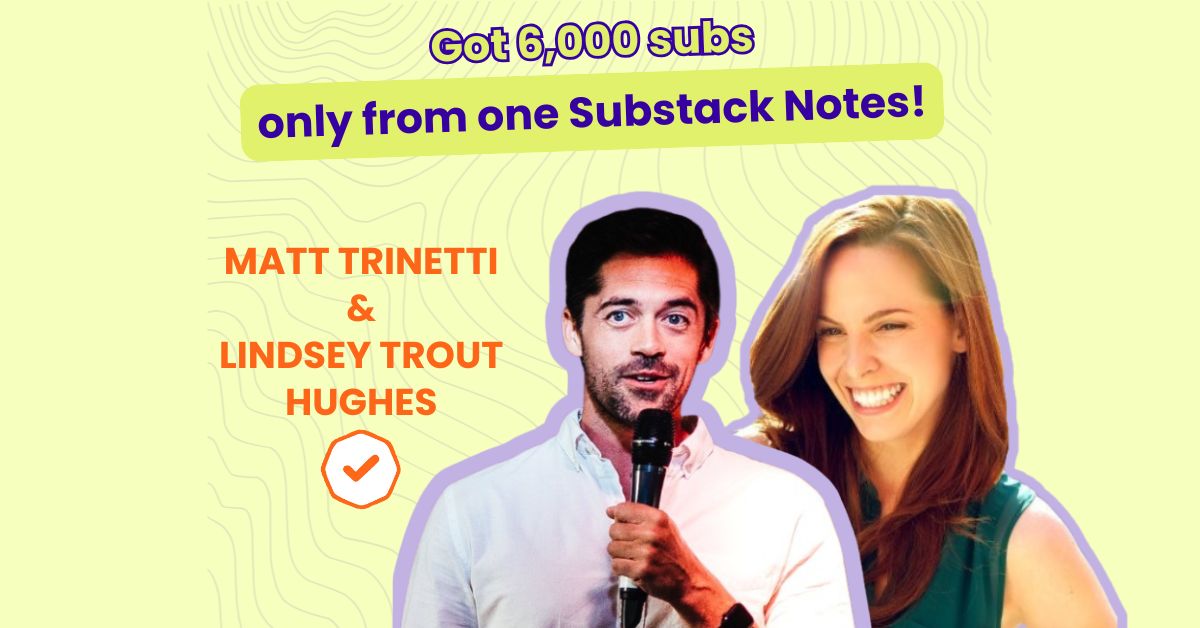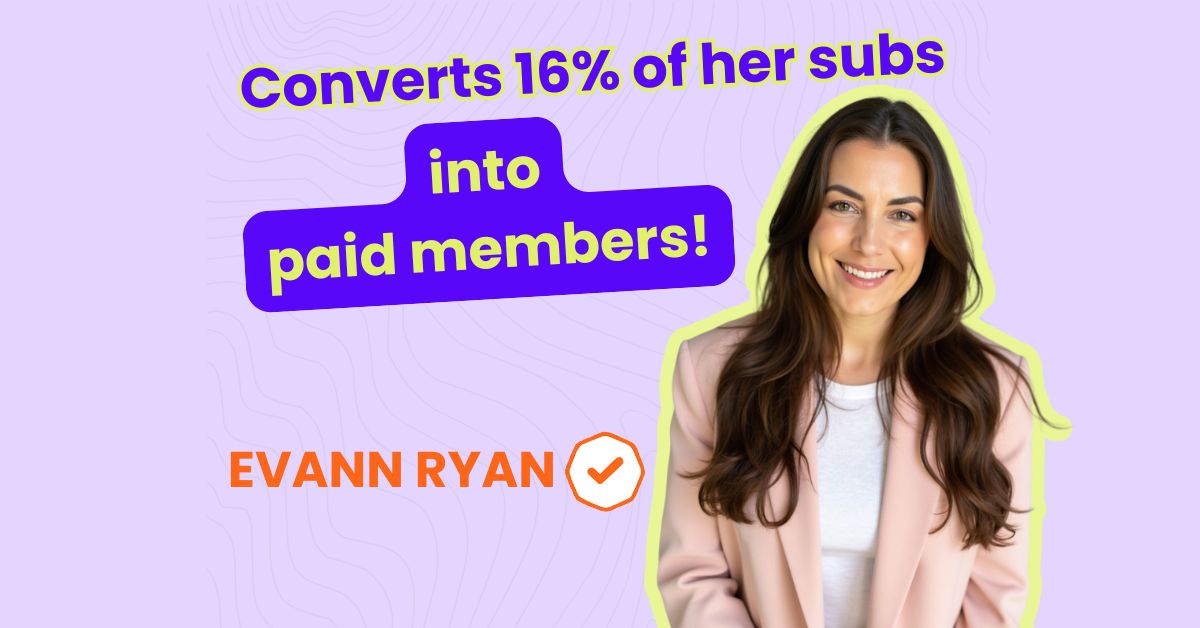Interview Date: Febraury 16, 2025
Table of Content
- Meet Kristina God
- Newsletter Identity Card
- Tools she uses to run her newsletter
- How she started The Online Writing Club
- How she grew over 11,000 subcribers
- How Substack Notes brings Kristina 250 subscribers per month
- Her strategies to become a Substack Bestseller
- Personal & professional impact of running a newsletter
MEET THE CREATOR
Today, we are welcoming Kristina God, a successful writer with 15 years of experience in journalism, PR, and marketing.
At one point, she ranked among the top 1,000 writers on Medium, earning around $1,000 per month. However, seeking a more sustainable income, she launched a free newsletter on Substack, called The Online Writing Club.
She waited 1.5 years to turn on paid subscriptions—and within less than a year after she turned it on, she became a Substack bestseller!
In this interview, you’ll learn:
- Why she started a newsletter on Substack even though she was making $1,000/month on Medium
- How she reached over 11,000 subscribers within 2 years
- How she generates almost $3,000+ per month solely from paid subscriptions
- How The Online Writing Club has impacted her professional journey
NEWSLETTER IDENTITY CARD
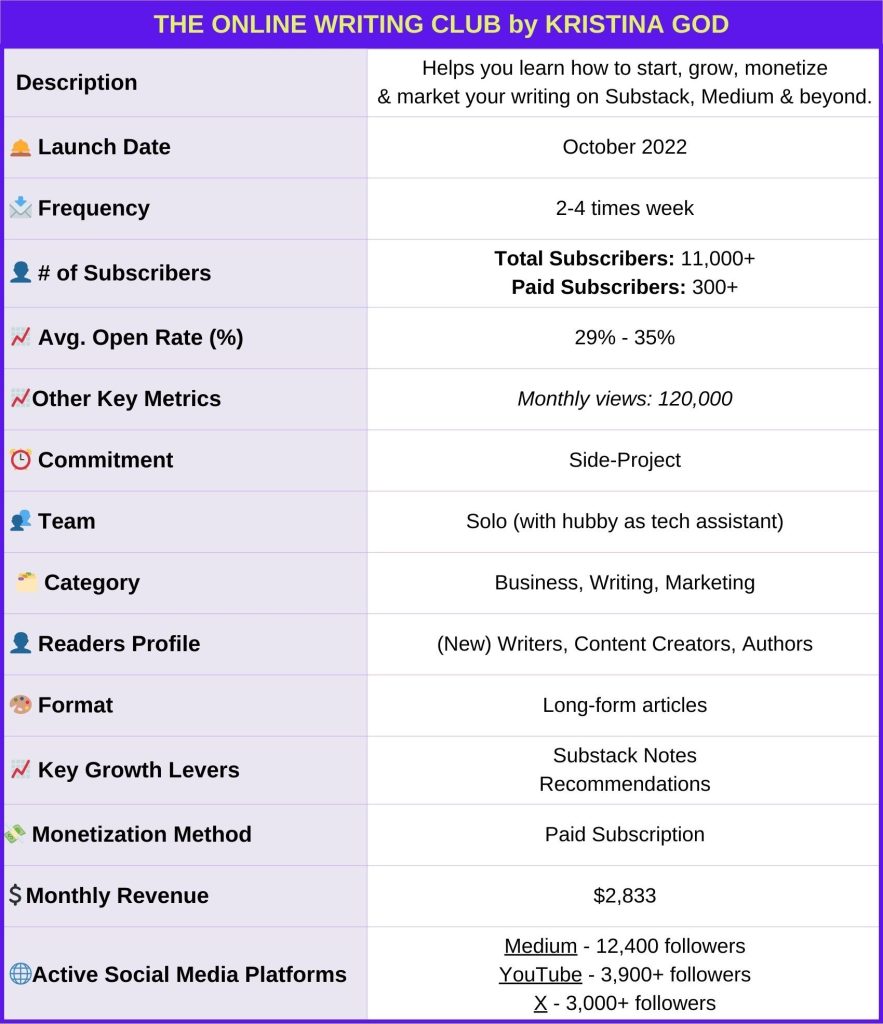
TOOL STACK
- ESP: Substack
- Writing: Grammarly
- Design of visuals design: Adobe
- Webinars: Zoom
- Digital Products: Teachable
- Community: Circle
START
You are a top writer on Medium (see here), yet you started publishing a newsletter on Substack in 2022. How and why did you start The Online Writing Club in the first place? How do you position your Medium and Substack?
I started my Substack newsletter in the fall of 2022 because I wanted more freedom—no more being at the mercy of algorithm changes on platforms like Medium.
“At the time, I belonged to the top 1,000 Medium writers and earned about $1,000/month on Medium, which was a huge milestone for me, but I knew I needed something more sustainable. So, I decided to focus on building an email list I actually owned and creating a content funnel and content flywheel.”
Substack became the perfect foundation for my content flywheel and funnel. I used Medium, YouTube, and other platforms to bring people onto my email list. The Online Writing Club was my way of helping writers kickstart their journey, grow their audience, and eventually monetize their writing.
At first, I wasn’t even thinking about making it a paid newsletter. My plan was to monetize through coaching and Bootcamps. But as the newsletter grew, it naturally evolved into a paid offering—and here we are!
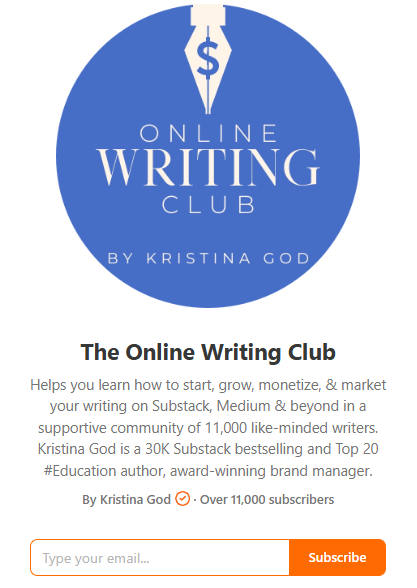
GROWTH
You grew your subscriber number from 0 to 10,000 in less than 2 years. This is impressive. How did you gain your first 1,000 subscribers?
Growing my first 1,000 subscribers in five months was all about starting with free content. I wanted people to get to know me, see my experience and expertise in marketing and journalism as an authority, connect with my writing, and—hopefully—fall in love with it. My focus was on building trust and offering value first, rather than jumping straight into monetization.
Authenticity, authority, and consistency were my guiding principles. I made sure every newsletter felt like a conversation, something real that people could relate to. Trends, the latest news, topics I and/or my audience cared about.
By consistently showing up with personable, original, valuable content with tangible tips based on my experience as an award-winning marketing and brand manager and journalist, I built authority in my niche—and people started sticking around – although I got pregnant and for 1.5 years couldn’t be as prolific as I wanted to be 😂
I shared my newsletter across platforms like Medium, YouTube, and Twitter (X), where I already had a small audience. Back then, Twitter made it easy for users to subscribe.
My tip for the first 1,000 subs:
“Show up authentically, give people a reason to trust you, and stay consistent – even if you have a job, family, are pregnant, or have a hundred things to juggle. Make the time to show up. That’s how you turn casual readers into subscribers and subscribers into fans and supporters.”
Watch this video or this article for more detail on this topic.
Which strategies did you use to grow over 10,000 subscribers?
1,000 – 2,500 Subscribers
I only knew email lists from my corporate job—structured, strategic, but nothing personal. Sure, I had built lists for my courses and bootcamps, but those were just promos and info emails, not actual newsletters.
This time, it was different. I wanted to build a personal brand. Let people know who Kristina is, what she stands for, and what she brings to the table based on her experience and expertise.
However, I gave everything away for free—honestly, I was just there (because I was feeling sick all the time). I knew an email list was important (marketing manager brain 💡), and that email is one of the best ways to connect with your people.
So, I wrote, shared, and focused on just one person. Always. That’s where the HOPE principle comes in (which many loved from my video).—Help One Person Every day. If I could help just one person, that was already a win. And if there were more like them? Even better. That’s how real connections start.
“On top of that, I knew recommendations mattered, so I started recommending other writers and creators I knew from Medium or found on Substack—but without any real strategy. Little did I know, those recommendations would bring in thousands of subscribers.”
2,500 – 5,000 Subscribers
At that point, I wanted to turn the trust and authority I’d built into something bigger—a thriving community. I renamed my newsletter from Kristina’s newsletter to The Online Writing Club.
A space where people didn’t just follow me (Kristina God, who is this person? Is this even her real name?) but saw me as a gatherer—someone who brings people together, sparks connections, and creates real engagement.
That’s why I launched my premium newsletter—not just as a paid upgrade, but as a way to build that community.
I started using Notes on a regular basis.
5,000 – 8,000 Subscribers
“I started using Notes every day—and honestly? This was a game-changer for me.”
I found so many amazing interview partners just by hanging out there. I quickly realized Notes was the perfect way to get my stories in front of more people thanks to Substack’s built-in audience, connect with awesome writers, and stumble upon some seriously cool personalities.
I also continued hosting live sessions with the writers and creators I interviewed. It made the membership experience way more interactive and personal.
On top of that, I opened the doors for my members to share guest posts, giving them a platform to showcase their work and shine.
8,000+ Subscribers
After a long hiatus, I launched my first Substack Bootcamp—before that, I was all about creating online courses, writing on Medium, and teaching people how to hype themselves up. But this was different.
Spending 5 to 10 intense days together meant people got to really know me, and that connection made a huge impact. Around the same time, Substack recommended I start a native podcast instead of just posting interviews and tutorials on YouTube. So, I listened—and launched my podcast.
I also started experimenting with my paywall. Instead of keeping 30% of my content behind it, I upped it to 40-50%. And guess what? It worked. People who already knew my posts were insightful and valuable didn’t want to miss out.
Meanwhile, my content bank inside the membership kept growing—more videos, resources, frameworks, and templates—making it even more valuable for members.
And, of course, word of mouth. People loved what I was doing and started recommending me to their friends and peers. To be honest, that’s the best kind of growth.
Substack Notes brings you 250 subscribers monthly on average (see here). What are your key strategies to gain new subscribers from Substack Notes?
In my opinion, Substack Notes is like a whole new genre of (short form) writing, and I absolutely love it! It’s a unique space where you can share mini memoirs, LinkedIn or X-style posts, repurpose your best-performing content from other platforms, re-stack your Substack newsletter stories, share links to other platforms such as YouTube without getting punished for it with zero views, or even pull snippets from your Medium stories.
“What makes it special for me is the spontaneity—I write Notes in the moment, whether I’m traveling with my family or pushing the stroller during the day. I’ve never done this before. I didn’t trust other platforms as much as I do Substack.”
Of course, you can also be really strategic about it. Inside my Club, I share how other successful small and big writers are using Notes to grow their audience. I’m not that strategic about it (yet).
The best thing about Substack Notes for me is that you don’t have to be perfect—you just have to be real. I’m all about sharing the messy stuff: the projects that flopped, the early drafts, or courses that make me cringe. I post real numbers and results—the wins and the losses. My crazy family life. Pictures from the beach.
I think (casual) readers and followers on Substack don’t connect with perfection. They connect with the journey. When you let them see the behind-the-scenes chaos as a working mom, you’re saying, ‘Hey, I’m figuring this out too.’ And honestly, that’s so much more relatable than pretending you’ve got it all together. Because I’m struggling. A lot.
So, make your mess your message. Share the lessons, the failures, the awkward drafts. Not only does it build trust, but it also makes Notes way more fun—for you and your readers!
But please, no manufactured vulnerability. When my dad and mom (and myself) had to go to the hospital in November, I just informed my subscribers and readers and took a break from writing for 6 weeks. But if you’re in a crisis and you want to share it, go for it. I just wouldn’t do soul striptease. You might regret it one day.
You also share videos from your YouTube channel in your newsletter and Substack Notes. What are the benefits of using video format for subscriber engagement and growth?
Some people think Substack is secretly trying to become TikTok just because more creators are posting videos. But honestly, for those short-form creators, YouTube might actually be a better fit. Substack is great for deeper engagement and long-form content, and video just adds another layer to that. It’s not about replacing writing but enhancing it.
In my opinion, video makes everything more engaging! Seeing my face and hearing my voice builds a real connection, way more than just text. Plus, it makes learning fun, can boost email open rates, and keeps my content alive across platforms.
That’s exactly why I launched my YouTube channel in fall 2022—right alongside my Substack newsletter. As a non-native speaker, I wanted to grow beyond just words and, honestly, get comfortable talking to a camera without looking like a deer in headlights.
As a busy mom, I love to repurpose my stuff and cross-promote it. It takes hours for me to write the script (or hit record and talk), edit, and upload the videos. Way more hours then just writing a text. The more eyeballs I get on my videos the better. I now also go LIVE on Substack.
“The first time was really scary, but once you’ve dared to hit that ‘Go Live’ button, it can become addictive, too ^^ It’s like a surprise egg—you never know who will join the live video, ask questions, or even step onto the virtual stage and suddenly start discussing a topic with you. I met wonderful friends and people there.”
Regarding growth efforts, what would you do differently if you had a chance to start over?
If I could hit reset, I’d go all-in on community from day one. I’d be in the chat, asking questions, getting people to share their stuff, and making real connections.
“Funny enough, I even wrote about Notes on Medium but didn’t start using it myself until January 2024… and that’s when my growth really took off. So yeah, if you’re starting from zero—no subs, no earnings, no following—jump on Notes ASAP.”
That’s exactly why I run my Substack Notes Kickstarter Bootcamps to help smallstackers and midstackers with 1, 10, 100 or 1,000 or 10,000 subs to get on Notes and capitalize on it. Bootcampers are seeing insane results because the network effect is wild. When you connect with a group, engage generously, and restack (share) each other’s work, your subscriber count gets a serious boost.
My Notes Bootcamp 2025 is happening this March. Co-host is my friend and tribe member David Mcllroy.
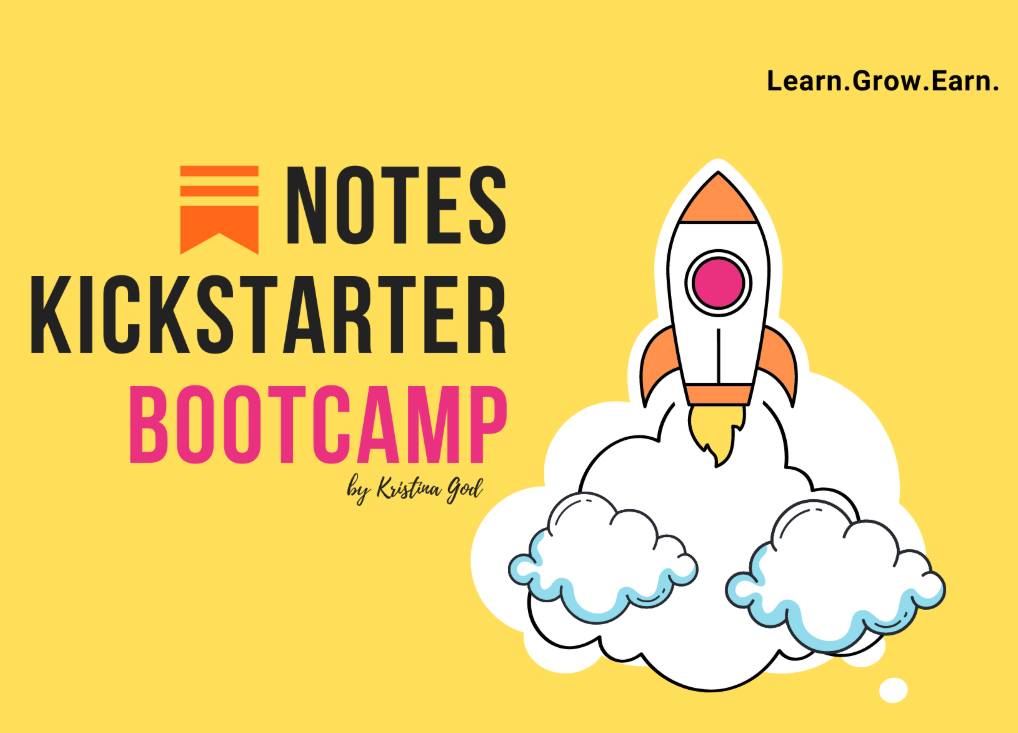
MONETIZATION
Your primary monetization channel is paid subscription. When was the right time for you to start paid subscription for your newsletter? How long did it take to monetize your newsletter?
If I could hit reset, I’d dare to hit that paid button way earlier. I kept waiting—thinking I needed to publish 52 newsletters in a row before I was “ready.” Spoiler alert: there’s no such thing as ready. Too late, I realized I could have offered everything for free while still giving people the option to support me.
That’s why I chose the freemium model: 70% free, 30% paid. But here’s the thing—paid subs don’t just get extra newsletters. They get way more perks.
I finally launched my premium newsletter in January 2024—after 1.5 years of giving everything away for free. What changed? Well… I had a baby. And suddenly, after months of feedback on Substack and Medium (and years of writing online), I knew exactly what I wanted to offer.
Truth is, there will never be a perfect time to hit that paid button. Start before you feel ready. Offer people the chance to support you—even if you have zero subscribers. You’d be surprised—sometimes it’s your partner, your mom, your dad, a coworker, or even a neighbor who believes in you first.
(For the record, no one from my family is on my paid list… yet. 😆)
To sum it up, I waited 1.5 years to monetize. If I could start over, I’d do it right from day one. Because even with zero subscribers, I still could’ve given everything away for free and let people support me.
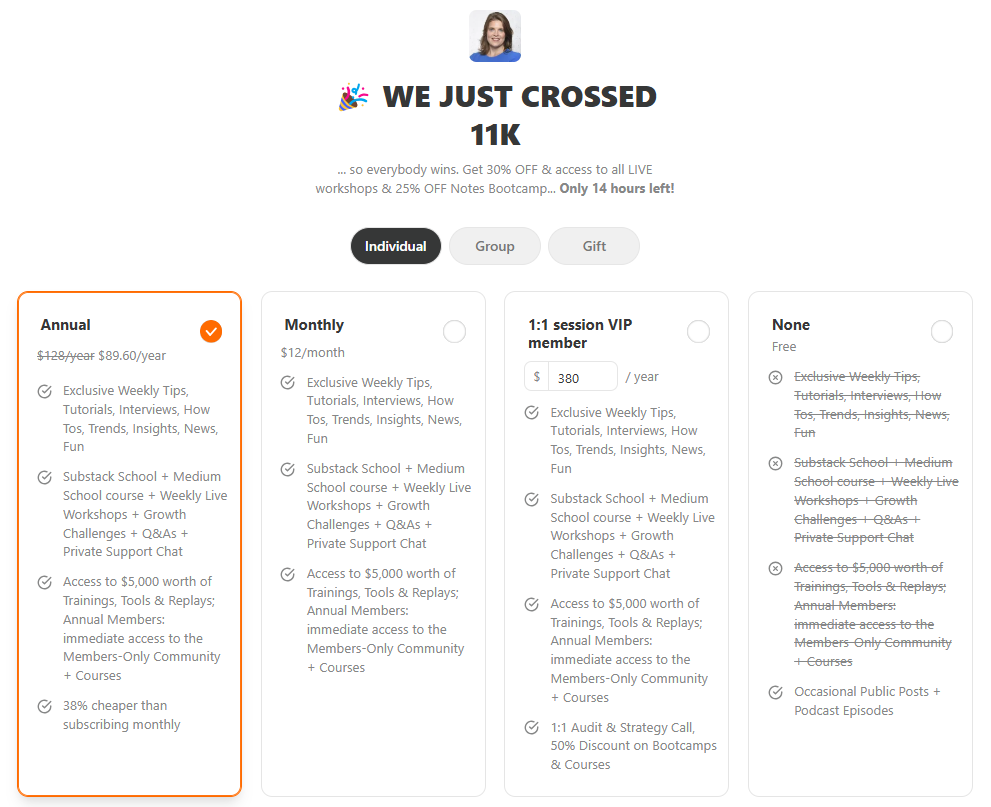
You have over 300 paid subscribers at the moment. What are your strategies for converting free subscribers into paid ones or gaining new paid subscribers? (see here)
I look at this from two angles—as a marketing manager and as a reader. And honestly? It’s so much more than just a newsletter. Even the biggest Substack writers offer more than just their newsletters—so why wouldn’t I? I share my podcast and YouTube interviews and I invite my readers to actually meet these successful and inspiring writers inside my “The Online Writing Club” membership experience—where they also get all the other awesome perks.*
Thanks to my content flywheel (YouTube + Medium + Substack), I’m constantly bringing in new people from different platforms, too. But my time is limited. With 2-4 hours in the evening and maybe some hours in the morning, I can’t personally reach out to everyone. But when I can? I personally invite the most engaged readers—the ones replying to my emails, showing up, and taking action.
And for those who need marketing help or want to go even deeper? That’s where my third-tier membership comes in—with 1:1 help that I no longer offer to non-members.
For me, it’s all about creating a value-packed, immersive experience. It is not just a newsletter—it is a thriving community and a place to connect and grow. It’s a buzzy Club. A real writer’s club with energy, connections, collaborations, and that inside-circle feel.
How did you decide what to offer differently to paid subscribers to make it compelling for them to join as paid members?
Now, my paid subscribers get access to my weekly live writer workshops—where they can learn from both small and big-name writers I interview for my YouTube channel and Substack podcast. They also join my invite-only community packed with courses, replay archives, accountability buddies, and direct access to me. Plus, they get discounts on my bootcamps and courses.
But back then? I didn’t have all of this—I just had a deep desire to build a community, help people start on Substack and Medium, and show them that making money online was actually possible.
Then I had my baby, and suddenly, everything clicked. It became about giving, growing together, and truly connecting with real action-takers. When I see someone taking action, I go all in—I overdeliver, support, and do everything I can to help them succeed.
“That’s the energy behind my paid community. It’s not just about extra content—it’s about real support, deep connections, and making things happen together.”
IMPACT & LEARNINGS
How did building The Online Writing Club newsletter contribute to your life professionally and personally?
Starting my own thing changed my life—because for the first time, I built something I truly owned. I became my own boss.
For ages, my hubby—who’s a part-time YouTube creator—kept preaching that I should start a YouTube channel to scale my business. I resisted, hesitated, overthought it… but finally, I took the plunge. I launched my YouTube channel and built my email list. And guess what? He was impressed.
Now? I’m so happy I listened. Growing beyond words and Medium to start my own business was the best decision ever. Sure, I’m a solo creator, but I’m not alone—my hubby is my tech assistant, and my baby (along with my boy) is my sunshine manager. 🌞
“More than anything, I’ve gained confidence—to speak in English, help people with my marketing and writing knowledge, with my skill to make people shine and show them how awesome they are, and actually get paid for what I do. I’m constantly learning, meeting incredible people from around the world while sitting in the attic in the evening (or after midnight…), and seeing real results for my tribe members.”
And when I see my tribe members succeed? My heart skips a beat.
What would you do differently if you had a chance to start over The Online Writing Club?
I mentioned this earlier, but honestly—looking back, it’s kind of wild. Between being pregnant, feeling sick every single day, and having a kid in the house, it’s a miracle I managed to publish multiple newsletters a month and show up on Medium every single day (thanks to batch creating, of course!)
As for the community aspect? I could’ve definitely leaned into Notes and Chat way earlier instead of just writing about it. But hey, live and learn, right? If anything, it just proves that even in total chaos, showing up consistently pays off.
What would it be if you had the right to give one piece of advice to aspiring newsletter creators?
Start before you’re ready. Because guess what? You’ll never feel 100% ready.
The secret?
“Stop finding excuses (I’m tired. I don’t have time. I have a baby. I’m pregnant. I have a 9-5. I won’t make it. I don’t know how and where to start) Take action anyway. Show up for yourself, put yourself out there, and keep moving forward.”
That’s how you get ahead of 99% of writers—not by waiting, but by doing and taking inspir-ACTION. No worries, The Online Writing Club can support you.
3 Popular The Online Writing Club Issues
- How to Get More Subscribers With Substack’s (New) Growth Engine
- My Simple & Proven 3-Step Approach to Get a Google Business Card
- I Suffer From Platform Fatigue and I Bet You Do Too (Without Knowing It)
Where to find Kristina God
- “The Online Writing Club” Newsletter
- X
- YouTube
- Medium

